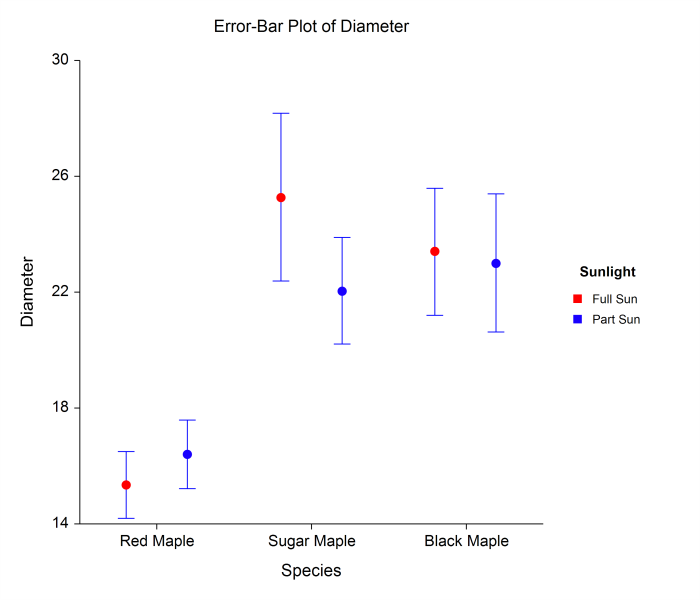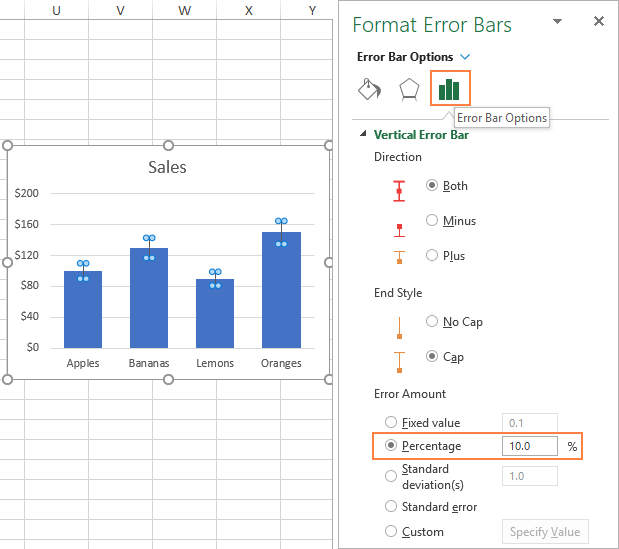

- #ERROR BARS NOT AT TOP OF GRAPH R HOW TO#
- #ERROR BARS NOT AT TOP OF GRAPH R CODE#
- #ERROR BARS NOT AT TOP OF GRAPH R SERIES#
Set your own amounts for fixed value, percentage and standard deviation error bars.Picking More Options opens the Format Error Bars pane where you can: More Options… - allows specifying your own error bar amounts and creating custom error bars.By default, the bars are graphed with 1 standard deviation for all data points. Standard Deviation - shows the amount of variability of the data, i.e.Percentage - adds error bars with the default 5% value, but you can set your own percentage by choosing More Options.Standard Error - displays the standard error of the mean for all values, which shows how far the sample mean is likely to be from the population mean.Click the arrow next to Error Bars and pick the desired option:.Click the Chart Elements button to the right of the chart.In Excel 2013 and higher, inserting error bars is quick and straightforward:
#ERROR BARS NOT AT TOP OF GRAPH R HOW TO#
How to make individual error bars of different lengths.
#ERROR BARS NOT AT TOP OF GRAPH R SERIES#
How to put error bars for a specific data series.How to add error bars in Excel 365 - 2013.For this, they calculate confidence intervals, or margins of error, and display them by using what is known as error bars. And because scientists love quantifying things, they found a way to quantify uncertainty. In science, uncertainty is the beginning of an investigation. In medicine, it generates innovations and leads to technological breakthroughs. In business, it prepares your company for the future. In truth, uncertainty is not a bad thing. Many of us are uncomfortable with uncertainty because it is often associated with lack of data, ineffective methods or wrong research approach. You will learn how to quickly insert standard error bars, create your own ones, and even make error bars of different size that show your own calculated standard deviation for each individual data point. 08, position = position_dodge(0.The tutorial shows how to make and use error bars in Excel. # show plot w/ errorbars, note that argument to position_dodge is same as width supplied aboveĪ.bar + geom_errorbar(width =. Scale_y_continuous(breaks = pretty_breaks(n = 8)) + Geom_bar(stat = "identity", position = "dodge", width = 0.5) +

# manually setting the width means we will have to tell geom_errorbar() about the new width # return plot with everything except error bars Putting it all together: require(ggplot2)Ī <- ame (Cond = c("In", "In", "Out", "Out"), Then you've got to make sure your geom_errorbar() looks like #.

Geom_bar(stat = "identity", position = "dodge", width = 0.5) The main problem was that the width argument in geom_bar has to match the position_dodge() argument inside geom_errorbar. I don't think any of those things were the ultimate problem, but they did make it harder to debug your code. You also set the group aesthetic in geom_errorbar(). In your code, you were setting the fill aesthetic twice, once in ggplot and once in geom_bar. In general, it's a good practice to set all your aesthetics in the original ggplot() call, and to override them with different aesthetics only if needed in the individual geom_xyz() calls. I would very much appreciate help on this. This moved the error bars towards the center of the columns, yet also moved the columns towards each other, eventually making them overlap (see attached figure). Geom_errorbar (aes(ymin = Score - SE, ymax = Score + SE, group = Cond), position = position_dodge(.5), width =. The closest solution was when I changed the position_dodge() argument into: geom_bar (aes(fill = Temp), stat = "identity", position = position_dodge(width =. The alternative codes I have tried, which I couldn't get to work either, included adding "show.legend = FALSE" to geom_bar() adding "facet_wrap(~Cond)" plot.a and introducing "fill = Temp" within ggplot(aes()). Scale_y_continuous (breaks = pretty_breaks(n=8)) + Geom_errorbar (aes(ymin = Score - SE, ymax = Score + SE, group = Cond), position = position_dodge(.9), width =. Geom_bar (aes(fill = Temp), stat = "identity", position = "dodge", width =. Theme_bw() + theme(id = element_blank ()) +
#ERROR BARS NOT AT TOP OF GRAPH R CODE#
The code I am using is this: a <- ame (Cond = c("In", "In", "Out", "Out"),Ī.bar <- ggplot (data = a, aes(x = Cond, y = Score, fill = Temp)) + I am having a problem with my bar chart- the error bars just appear on the corner of the columns of the grouping variable rather than on them in a centralised way.


 0 kommentar(er)
0 kommentar(er)
